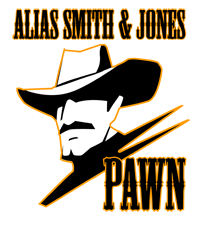How Pawn Shops Work
How does a pawn shop work?
Pawnbrokers lend money on items of value ranging from gold and diamond jewelry to musical instruments, televisions, tools, household items, and more!. These items maintain their value over a reasonable period of time and are easy to store, especially jewelry. All customers provide collateral, eliminating the need to distinguish high risk from low risk borrowers. Typically, loans are small averaging between $70 and $100, although they can be as small as $20 or as high as several thousand dollars depending on the value of the collateral. Contracts vary, but the average loan period is 30 days. Generally, interest rates will vary with the amount of the loan. The process is much the same as any other lending institution, with the primary difference being the size of the loan, the collateral and the holding of the merchandise until the interest or the loan has been repaid or the loan period expires.
Why would someone go to a pawn shop to get a loan?
Pawnshops offer consumers a quick, convenient and confidential way to borrow money. A short term cash need can be met with no credit check or legal consequences if the loan is not repaid. A customer receives a percentage of the value the broker believes the collateral would bring in a sale. Although the loan to collateral ratio varies over time and across pawnshops, a loan of about 50 percent of the resale value of the collateral is typical. In other words, pawnbrokers feel their loan is “paid in full” at the time it is made. When a customer pawns an item, terms of the loan are printed on a pawn ticket that is given to the customer. The ticket states the customers name, address, type of identification provided to the pawnbroker, a description of the item, amount lent, maturity date, interest rate and amount that must be paid to redeem the item. Most states regulate pawnshop interest rates and other charges, such as storage or insurance fees.
What is the foreclosure procedure?
If a customer defaults by not repaying the loan, the collateral becomes the property of the pawnshop after the loan is overdue by a specific amount of time, generally one to three months.
Do most pawning customers lose their merchandise?
No. On average, 70 to 80 percent of all loans are repaid. Repeat customers make up most of our business, similar to any other lending or retail establishment. Pawnbrokers know the vast majority of their customers because they often borrow against the same items over and over again. Pawnbrokers offer non-recourse loans, looking only to the item being pledged to recover their investment should the borrower choose not to repay the loan. It is solely the choice of the customer whether he/she elects to repay the loan.
Are pawn shop rates excessive?
To provide the loan service, all lenders must charge rates commensurate with risk, size and duration of the loan, collateral offered, and recourse. Pawnshop loans are small dollar, high risk, short duration loans. The item stands as the sole collateral offering no other recourse. And pawnbrokers are liable for replacement value if something happens to the item in their care. There are no hidden charges as with other lending institutions. On the other hand, pawnbrokers cost basis is far greater. They incur cost for security, handling, storage, and regulation not incurred by others. Due to the 15-20% of pawn shop customers that elect not to repay their loans, pawnbrokers are forced to turn their “bad debt” into a retail center to recover their cost. Other lending institutions do not incur retail cost including additional floor space, gondolas, counters, personnel, advertising, shop lifters, retail competitive cost, and new merchandise cost to supplement the unredeemed goods.
How can I be sure the merchandise I purchase at a pawn shop isn’t stolen?
Less than one fifth of one percent of all collateral is even suspect as having been misappropriated in any manner. Thieves and robbers are a pawnbrokers worst enemy. Pawnbrokers work closely with local law enforcement to catch and prosecute these perpetrators. A customer must provide positive identification to show evidence of the transaction. This information is then presented to the police department, therefore decreasing the likelihood that a thief would bring stolen merchandise to a pawnshop. Pawnbrokers are trained to look for signs of stolen property to avoid these costly mistakes. It is not in the interests of the pawnbroker to accept potentially stolen merchandise because the police can seize the merchandise and the pawnshop owner loses the collateral and the loaned money.
What is the difference between buying at a pawn shop and buying at a retail store?
Mainly price. Pawnshops can offer you merchandise ranging from 1/3 to 1/2 off retail prices.
Are pawn shops a “bad times” industry?
Pawnshops survive bad times if they make adjustments both at the retail and loan counters, but they do far better in good times. In hard times, customers move away to find employment, have less ability to repay their loans and the value of all merchandise goes down. Merchandise values go down because the major retail discounters sell for less to maintain or broaden market share. If retail merchants sell for less, pawnbrokers must loan less thus earning a smaller return. Regardless of income level, most people periodically borrow money. In good times, customers are more able to repay their loans and unredeemed merchandise sells faster because customers have more discretionary income.
Do pawn shops attract indigents and derelicts?
Absolutely not. Indigents and derelicts have no assets to use as collateral. No one builds a business around these people. The typical pawnshop loan customer is employed, living within one mile of the store, is of either sex, and occasionally needs short term cash for an unexpected bill such as a medical expense or car repairs. The typical pawnshop retail customer is a bargain hunter, either by need or desire and comes from all walks of life. Most pawnshop customers are repeat customers.





Follow Us!